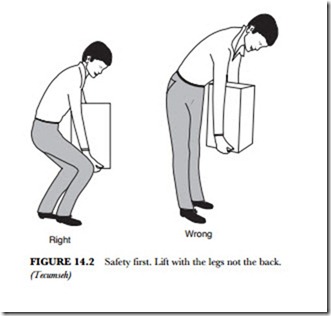HANDLING REFRIGERANTS SAFELY
One of the requirements of an ideal refrigerant is that it must be nontoxic. In reality, however, all gases (with the exception of pure air) are more or less toxic or asphyxiating. It is therefore important that wherever gases or highly volatile liquids are used, adequate ventilation be provided, because even nontoxic gases in air pro- duce a suffocating effect.
Vaporized refrigerants (especially ammonia and sulfur dioxide) bring about irritation and congestion of the lungs and bronchial organs, accompanied by violent coughing, vomiting, and, when breathed in
sufficient quantity, suffocation. It is of the utmost importance, therefore, that the serviceman subjected to a refrigerant gas find access to fresh air at frequent intervals to clear his lungs. When engaged in the re- pair of ammonia and sulfur dioxide machines, approved gas masks and goggles should be used. Carrene, Freon (R-12), and carbon dioxide fumes are not irritating and can be inhaled in considerable concentra- tions for short periods without serious consequences.
It should be remembered that liquid refrigerant would refrigerate or remove heat from anything it meets when released from a container. In the case of contact with refrigerant, the affected or injured area should be treated as if it has been frozen or frostbitten.
Refrigerant cylinders should be stored in a dry, sheltered, and well-ventilated area. The cylinders should be placed in a horizontal position, if possible, and held by blocks or saddles to prevent rolling. It is of utmost importance to handle refrigerant cylinders with care and to observe the following precautions:
• Never drop the cylinders or permit them to strike each other violently
• Never use a lifting magnet or a sling (rope or chain) when handling cylinders; a crane may be used when a safe cradle or platform is provided to hold the cylinders
• Caps provided for valve protection should be kept on the cylinders at all times except when the cylinders are actually in use
• Never overfill the cylinders; whenever refrigerant is discharged from or into a cylinder, weigh the cylinder and record the weight of the refrigerant remaining in it
• Never mix gases in a cylinder
• Never use cylinders for rollers, supports, or for any purpose other than to carry gas
• Never tamper with the safety devices in valves or on the cylinders
• Open the cylinder valves slowly; never use wrenches or tools except those provided or approved by the gas manufacturer
• Make sure that the threads on regulators or other unions are the same as those on the cylinder-valve outlets.; never force a connection that does not fit
• Regulators and gauges provided for use with one gas must not be used on cylinders containing a different gas
• Never attempt to repair or alter the cylinders or valves
• Never store the cylinders near highly flammable substances (such as oil, gasoline, or waste)
• Cylinders should not be exposed to continuous dampness, salt water, or salt spray
• Store full and empty cylinders apart to avoid confusion
• Protect the cylinders from any object that will produce a cut or other abrasion on the surface of the metal
